
Concept explainers
(a)
Interpretation:
The isomeric structures of octane having five carbons in their principal chains are to be drawn. The naming for all the structures is to be stated.
Concept introduction:
The naming of the chemical compound is done using the parameters given by IUPAC. IUPAC stands for International Union of Pure and Applied Chemistry. This system of nomenclature is accepted worldwide. The IUPAC system provides the set of rules in order to do the naming of the chemical compounds.
Isomers are the chemical compounds which have same chemical formula but different arrangement of molecules.
Answer to Problem 2.26AP
The isomeric structures of octane having five carbons in their principal chains along with their names are drawn below as,
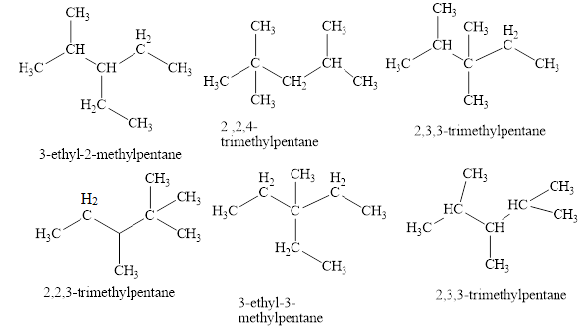
Explanation of Solution
The structure of octane can be drawn as shown in figure 1.
![]()
Figure 1
The isomers of the octane having five carbons in their principal chains can be drawn by rearranging the carbon atoms.
The first isomer is shown in figure 2 as,
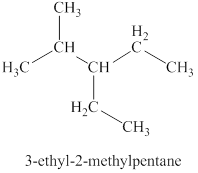
Figure 2
For the naming of the compound, the longest carbon chain is selected first. In the given compound the longest carbon chain has
The second isomer is shown in figure 3 as,
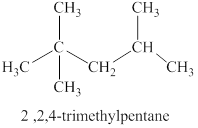
Figure 3
For the naming of the compound the longest carbon chain is selected first. In the given compound the longest carbon chain has
The third isomer is shown in figure 4 as,
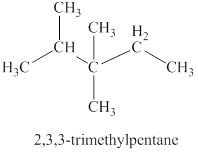
Figure 4
For the naming of the compound the longest carbon chain is selected first. In the given compound the longest carbon chain has
The fourth isomer is shown in figure 5 as,
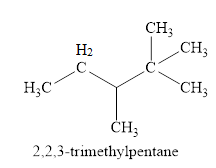
Figure 5
For the naming of the compound the longest carbon chain is selected first. In the given compound the longest carbon chain has
The fifth isomer is shown in figure 6 as,
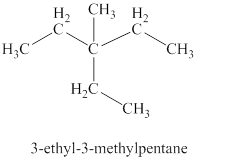
Figure 6
For the naming of the compound the longest carbon chain is selected first. In the given compound the longest carbon chain has
The sixth isomer is shown in figure 7 as,
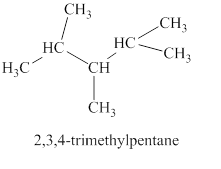
Figure 7
For the naming of the compound the longest carbon chain is selected first. In the given compound the longest carbon chain has
The isomeric structures of octane having five carbons in their principal chains along with their names are shown in figure 2 to 7.
(b)
Interpretation:
The isomeric structures of octane having six carbons in their principal chains are to be drawn. The naming for all the structures is to be stated.
Concept introduction:
The naming of the chemical compound is done using the parameters given by IUPAC. IUPAC stands for International Union of Pure and Applied Chemistry. This system of nomenclature is accepted worldwide. The IUPAC system provides the set of rules in order to do the naming of the chemical compounds.
Isomers are the chemical compounds which have same chemical formula but different arrangement of molecules.
Answer to Problem 2.26AP
The isomeric structures of octane having six carbons in their principal chains along with their names are drawn below as,
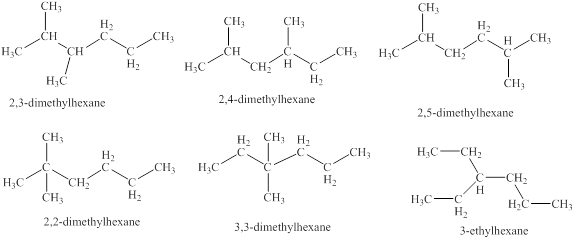
Explanation of Solution
The isomers of the octane having six carbons in their principal chains can be drawn by rearranging the carbon atoms.
The first isomer is shown in figure 8 as,
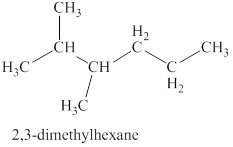
Figure 8
For the naming of the compound the longest carbon chain is selected first. In the given compound the longest carbon chain has
The second isomer is shown in figure 9 as,
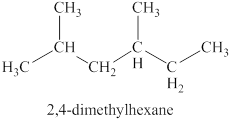
Figure 9
For the naming of the compound the longest carbon chain is selected first. In the given compound the longest carbon chain has
The third isomer is shown in figure 10 as,
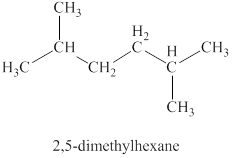
Figure 10
For the naming of the compound the longest carbon chain is selected first. In the given compound the longest carbon chain has
The fourth isomer is shown in figure 11 as,
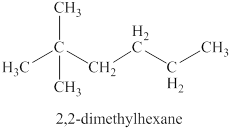
Figure 11
For the naming of the compound the longest carbon chain is selected first. In the given compound the longest carbon chain has
The fifth isomer is shown in figure 12 as,
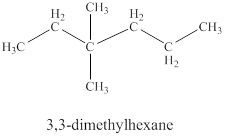
Figure 12
For the naming of the compound the longest carbon chain is selected first. In the given compound the longest carbon chain has
The sixth isomer is shown in figure 13 as,
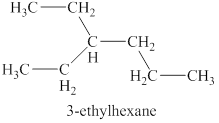
Figure 13
For the naming of the compound the longest carbon chain is selected first. In the given compound the longest chain carbon has
The isomeric structures of octane having six carbons in their principal chains along with their names are shown in figure 8 to 13.
Want to see more full solutions like this?
Chapter 2 Solutions
Organic Chemistry, Ebook And Single-course Homework Access
- Polymers may be composed of thousands of monomers. Draw three repeat units (trimer) of the polymer formed in this reaction. Assume there are hydrogen atoms there are hydrogen atoms on the two ends of the trimer. Ignore inorganic byproducts please.arrow_forwardi need help with the folarrow_forwardPLEASE HELP NOW! URGENT!arrow_forward
- a. Determine whether each of the Followery Molecules is in the R- On the y- Configuration 1-01"/ 1-6-4 Br 4 I el Br b. Draw The Fisher projection For all the Meso compounds that can exist FOR The Following molenlearrow_forward1- Refer to the monosaccharides below to answer each of the following question(s): CH₂OH CHO CH₂OH CH₂OH 0 H- OH 0 0 HO- H H- -OH HO H HO H H OH HO- H CH₂OH H. OH HO H HO- H CH₂OH CH₂OH CH3 a. Sorbose b. Rhamnose c. Erythrulose d. Xylulose Classify each sugar by type; for example, glucose is an aldohexose. a. Xylulose is .. b. Erythrulose is . c. Sorbose is .. d. Rhamnose is .. 2- Consider the reaction below to answer the following question(s). CHO H OH CH₂OH CH₂OH HO- H HO HO + H. -OH HO OH HO. H OH OH H -OH H OH CH₂OH Q Z a. Refer to Exhibit 25-11. Place a triangle around the anomeric carbon in compound Q. Compound Z is: b. 1. the D-anomer. 2. the a-anomer. 3. the ẞ-anomer. 4. the L-anomer. c. Which anomer is the LEAST stable? d. Q and Z are cyclic examples of: a. acetals b. hemiacetals c. alditols d. hemialditolsarrow_forwardi need help identifying the four carbon oxygen bonds in the following:arrow_forward
- Imagine each of the molecules shown below was found in an aqueous solution. Can you tell whether the solution is acidic, basic, or neutral? molecule HO H3N + The solution is... X O acidic OH O basic H3N-CH-C-O O neutral ○ (unknown) O acidic ○ basic CH2 CH 3-S-CH2 O neutral ○ (unknown) H3N O OH O acidic O basic Oneutral O (unknown) 0 H3N-CH-C-O CH3 CH CH3 O acidic O basic O neutral ○ (unknown) ? olo Ar BHarrow_forwardno Ai walkthroughs need other product (product in picture is wrong dont submit the same thing)arrow_forwardHow to solve this!arrow_forward
 ChemistryChemistryISBN:9781305957404Author:Steven S. Zumdahl, Susan A. Zumdahl, Donald J. DeCostePublisher:Cengage Learning
ChemistryChemistryISBN:9781305957404Author:Steven S. Zumdahl, Susan A. Zumdahl, Donald J. DeCostePublisher:Cengage Learning ChemistryChemistryISBN:9781259911156Author:Raymond Chang Dr., Jason Overby ProfessorPublisher:McGraw-Hill Education
ChemistryChemistryISBN:9781259911156Author:Raymond Chang Dr., Jason Overby ProfessorPublisher:McGraw-Hill Education Principles of Instrumental AnalysisChemistryISBN:9781305577213Author:Douglas A. Skoog, F. James Holler, Stanley R. CrouchPublisher:Cengage Learning
Principles of Instrumental AnalysisChemistryISBN:9781305577213Author:Douglas A. Skoog, F. James Holler, Stanley R. CrouchPublisher:Cengage Learning Organic ChemistryChemistryISBN:9780078021558Author:Janice Gorzynski Smith Dr.Publisher:McGraw-Hill Education
Organic ChemistryChemistryISBN:9780078021558Author:Janice Gorzynski Smith Dr.Publisher:McGraw-Hill Education Chemistry: Principles and ReactionsChemistryISBN:9781305079373Author:William L. Masterton, Cecile N. HurleyPublisher:Cengage Learning
Chemistry: Principles and ReactionsChemistryISBN:9781305079373Author:William L. Masterton, Cecile N. HurleyPublisher:Cengage Learning Elementary Principles of Chemical Processes, Bind...ChemistryISBN:9781118431221Author:Richard M. Felder, Ronald W. Rousseau, Lisa G. BullardPublisher:WILEY
Elementary Principles of Chemical Processes, Bind...ChemistryISBN:9781118431221Author:Richard M. Felder, Ronald W. Rousseau, Lisa G. BullardPublisher:WILEY





